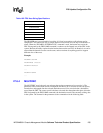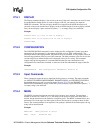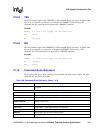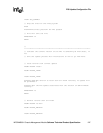
MPCMM0001 Chassis Management Module Software Technical Product Specification 241
FRU Update Configuration File
27.9.1 DISPLAY
The Display command displays a line of text to the user. If the text is more than one word, it must
be encapsulated in double quotes. In order to display a CR-LF, you must use two separate
DISPLAY commands. The text to display should be no longer than 80 ASCII characters to fit
correctly on the screen, but the line to display can be of infinite length. In order to display a blank
line, you must display a space enclosed in quotes (“ ”). An empty string is not sufficient.
Example:
DISPLAY “This is a line of text to display.”
DISPLAY “This is the second line of text to display.”
DISPLAY WORD
27.9.2 CONFIGURATION
The CONFIGURATION command is used to display the file configuration. It takes up to three
parameters; the first parameter is a description of the file, such as “FRU configuration”. The
second parameter is the target platform, this platform ID is not validated, so it is possible to have an
incorrect target platform listed as part of this command. The third parameter is the file version; the
version string has no defined format, and is displayed to the user as a string. This command
requires only the first argument. It is recommended that the first non-comment line of all
configuration file contain this command, so that users of the file understand the target of this file.
Example:
CONFIGURATION “FRU Configuration” “MPCHC0001” “Version 5”
27.9.3 Input Commands
These commands require the user to input data for the process to continue. The input commands
are: MENUTITLE/MENU/MENUPROMPT, PROMPT/YES/NO, and FRUFIELD. FRUFIELD
has multiple input types and is covered in chapter Section 27.8.5. For the PROMPT and
MENUTITLE commands to display a blank line, you must display a space enclosed in quotes (“ ”).
An empty string is not sufficient.
27.9.4 MENU
The MENU command presents the user with a list of answers for a question. The maximum
number of answers for a menu is 9, 1-9. The utility has the option to allow more menu items if
desired, but the selection must be limited to a single key press. The MENU command allows two
parameters. First is the tag to set if the option is chosen, and second is a prompt to show for that
answer. The second parameter is not required; if no prompt is defined for the menu option, the tag
string will be shown instead.
Example:
MENUTITLE “What platform is this?”
MENU “atca” “Advanced TCA”


















